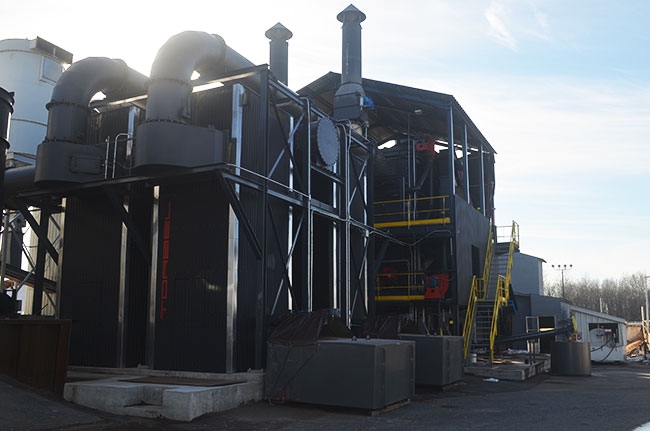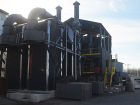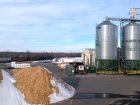
Features
Harvesting
Logging Profiles
Hot investment: $3M furnace upgrade keeps logging business going
Feb. 13, 2017 - When Pat Curran decided to get into the wood pellet business in 2007, it was to help ensure that the fibre from Curran’s family logging business Seaway Timber and Curran Logging based in Massena, N.Y. always had a home. When the pulp mill across the border in Cornwall, Ont., shut down, the logging business lost a big market for its wood chips.
February 13, 2017 By Andrew Snook
 Curran Renewable Energy based in Massena When Pat Curran decided to get into the wood pellet business in 2007
Curran Renewable Energy based in Massena When Pat Curran decided to get into the wood pellet business in 2007“We were starting to see some of our markets tightening up,” Curran explains during a tour of his pellet plant operation. “In order for us to be successful as a logging operator we need to have something close by.”
Fast-forward to present day, and not much has changed.
Supplying wood chips for pulp mills makes up a huge part of the family logging business, which mainly harvests the plentiful hardwood species that populate the region of upstate New York the company operates within. Curran’s logging business supplies chips to Domtar’s pulp mill in Windsor, Que.; Fortress Paper’s mill in Thurso, Que.; and International Paper’s plant in Ticonderoga, N.Y., in addition to producing sawlogs for a handful of customers in the area.
To ensure the company continues to have a variety of options for its fibre, Curran has given his pellet plant a significant upgrade in the form of a $3-million Torbel 15-MW fluidized bed hot gas furnace.
The investment in the new furnace has created multiple opportunities for fibre utilization. One option is to use the furnace to significantly increase wood pellet production at the plant. The plant only produced 60,000 tons of wood pellets this year due to decreased demand in the biomass wood pellet market, but had the capacity to produce upwards of 125,000 tons. With the new furnace and the rest of the plant operating at its current capacity, the plant will experience about a 15 per cent increase in production. This stems from the plant no longer having to burn its high-grade fibre for heat.
“We were burning 15 per cent of our nice clean fibre for energy at the same time that we have an abundance of low-grade fibre,” Curran says.
The uptick in efficiency stems from the gas cleaning system in the Torbel furnace. The unit is equipped with four multi-cyclone dust collectors that run in parallel. The multi-cyclones clean the hot gas, and separate ash, sand and burning particles prior to drying the wood fibre in the dryer. This improves the quality of the wood pellets produced, which Curran says is a key reason for the investment.
“It’s about holding on to your market,” he says. “Every producer wants to produce a cleaner, better pellet.”
Increased production potential doesn’t stop at 15 per cent. If the market demand was there, Curran says he could very quickly increase production by installing an additional dryer and doubling the infeed system, number of hammermills and pellet mills in the plant.
“If we ran this furnace at capacity we feel we could produce between 200,000 and 250,000 tons,” Curran says, explaining that the reason for the wide variance is because he hasn’t seen how the furnace will operate in the winter months. “For at least nine months of the year we could double production.”
Curran Renewable Energy currently produces five different types of pellets: a 70/30 hardwood-softwood mix, a pure hardwood mix, a pure softwood mix, hickory pellets for barbecues and a pure pine pellet used for animal bedding.
While walking the property of the plant and checking out its current layout, it was easy to see that Curran Renewable Energy definitely has the space to increase capacity if market demand improves. The company has even set itself up with the potential to ship by rail from the tracks that run parallel at the back end of the plant’s property; if the market picks up for bulk shipments. That said, Curran isn’t about to invest the cash in increased pellet production.
“Pellet market as it is, we won’t be doubling production right now,” he says, adding that there has been a perfect storm for decreasing demand in the pellet market with the combination of warmer winters, a high U.S. dollar and low oil prices. “It’s hard to see a prosperous position right now.”
Increasing wood pellet production wasn’t the only reason Curran decided to invest in the Torbel system. He is also looking at using the furnace for co-generation if he can get a long-term agreement in place with a local utility provider to generate excess energy that can be converted into electricity and be fed back into the grid. That way the pellet plant would have a steady stream of income coming in that isn’t sensitive to fluctuations in currency or oil prices.
Another option Curran has for optimizing his new furnace is to produce briquettes or use it for heating large greenhouses for drying sand – another resource he has an ample supply from his company’s local aggregate operations.
Another way Curran holds onto his market share in the wood pellet sector is by paying for third-party certification, which is performed by Timber Product Inspections. It is part of the requirements for ensuring a company meets the standards for the Pellet Fuels Institute’s (PFI) certification program.
“There’s a cost to this but it all comes back to quality,” Curran says, adding that third-party certification is extremely valuable to have if a customer that comes back with an issue related to the quality of the wood pellets they have purchased.
By ensuring his wood pellets are produced at the highest levels of quality and continuing to invest in fibre diversification strategies, Curran Renewable Energy is positioning itself to weather the current economic storm and be well positioned for future opportunities for growth when demand in the wood pellet market resurfaces.
Print this page

